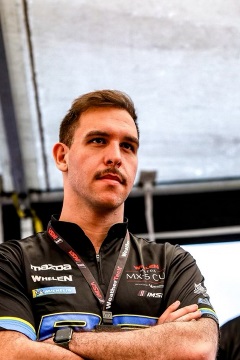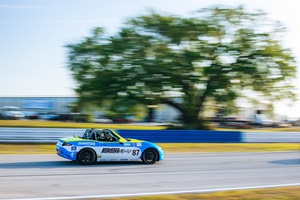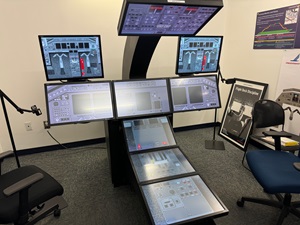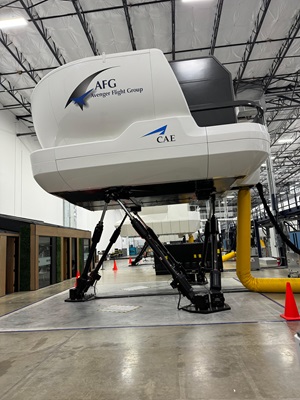
A question many Whelen Mazda MX-5 Cup presented by Michelin fans have asked lately is: ‘where’s Selin Rollan?’ The front-running series veteran was missing from Rounds Five and Six at WeatherTech Raceway Laguna Seca and isn’t on the entry list for Mid-Ohio.
But there is a very good reason that Rollan can’t be at the track—he’s in the sky.
Just as much as Rollan wanted to be a professional driver, he wanted to be a professional pilot. As soon as he passed the most stringent FAA medical test, he began banking the hours he needed to be a commercial pilot.
“The minimum requirement to be a commercial pilot is 250 hours,” Rollan explained. “A common misconception is that being a commercial pilot is being an airline pilot, but that’s not the case. Being a commercial pilot means you can make money flying, so that can be skydiving, crop duster, banner tow or something like that. There’s a big gap between 250 and 1,500 (hours) needed to be an airline pilot.
“The most common thing to do is, once you get your commercial license, you get a certified flight instructor license and that’s what I did. Every hour I was instructing—to get to my 1,500 hours—I was also earning for myself. That way I’m working, making money, not spending money, to earn hours.”
 Rollan finally logged hour 1,500 the week of the Mazda MX-5 Cup season opener at Daytona. He was hired by Piedmont Airlines, a subsidiary of American Airlines, at nearly the same time. After Daytona he was off to Dallas, Texas, for a required pilot exam, before heading to Charlotte, North Carolina, for training.
Rollan finally logged hour 1,500 the week of the Mazda MX-5 Cup season opener at Daytona. He was hired by Piedmont Airlines, a subsidiary of American Airlines, at nearly the same time. After Daytona he was off to Dallas, Texas, for a required pilot exam, before heading to Charlotte, North Carolina, for training.
“The first week is company procedures and setting up benefits and stuff like that,” Rollan said. “Then they sent us home for 10 days. That was time to do at-home study. We used computer programs on all the different systems on the plane; the landing gear, the engine, the brakes, the pressurization, stuff like that, to get a broad overview. With each section there’s a quiz at the end. If you pass it, you go on to the next step.”
He lucked out that after another two weeks of classroom study in Charlotte, he got a week off, the week of MX-5 Cup Rounds Three and Four at Sebring. Then it was back to training.
 “After Sebring I went back and did what they call ‘procedures training,’ which is essentially what buttons to press. We did this in, not a simulator, but a room with multiple touchscreens with all the buttons and you touch the screen and it activates the button. It’s meant to emphasize specific procedures.”
“After Sebring I went back and did what they call ‘procedures training,’ which is essentially what buttons to press. We did this in, not a simulator, but a room with multiple touchscreens with all the buttons and you touch the screen and it activates the button. It’s meant to emphasize specific procedures.”
Then it was time for the part most people would associate with pilot training: the simulator. In Dallas, Rollan was put to the test with dangerous and abnormal scenarios.
“The simulators are pretty crazy,” Rollan said. “They’re tens of millions of dollars. It’s more advanced than any racing sim I’ve ever been in. The instructors are there and they press a button that says turbulence and the thing shakes. When you’re on the brakes on the runway after you land, you feel it pushing you forward. Seeing these things from the outside, on the ground level is crazy, these things are 30 feet in the air.”
 After practicing worse case scenarios, training turned to the more mundane. LOFT, or Line Orientated Flight Training, was all about point A to point B, takeoff and landing, like a pilot’s typical day.
After practicing worse case scenarios, training turned to the more mundane. LOFT, or Line Orientated Flight Training, was all about point A to point B, takeoff and landing, like a pilot’s typical day.
With every test passed and every box checked, Rollan is now in the cockpit for Piedmont Airlines. Not as a Captain, however, as a First Officer a.k.a. Co-Pilot.
“When I’m the Co-Pilot, it’s not a regular Captain I’m with, it’s a higher up Check Airman Captain that’s going to observe me and work with me for 40 hours. Then he’ll sign me off and I’m a normal pilot. The first time I fly won’t be empty, there’ll be people in the back.”
And so the journey continues; as Rollan clocks more hours, he can apply to fly bigger planes and with bigger airlines. For now, it’s an Embraer 145, flying regional routes in and out of Philadelphia, but he hopes one day he might get to fly an Airbus A350 or a Boeing 787.
So, what’s harder: landing a plane or winning a MX-5 Cup race?
“Winning a MX-5 race is harder,” he laughs. “I can land a plane any day, but a Cup race, that takes a lot more variables to go your way!”